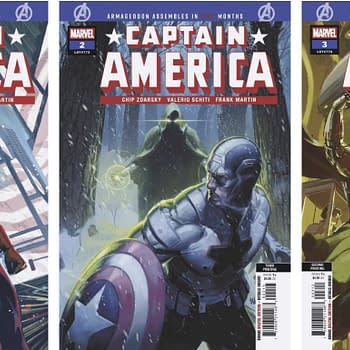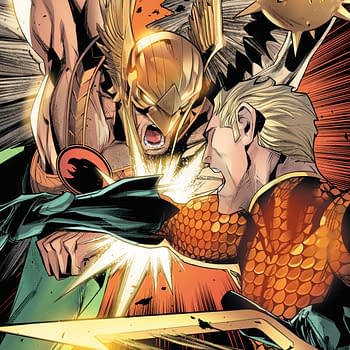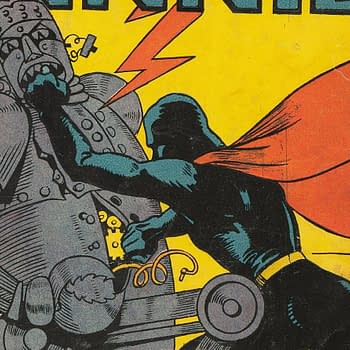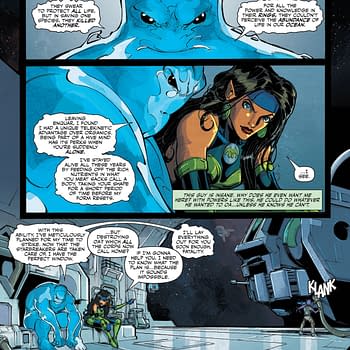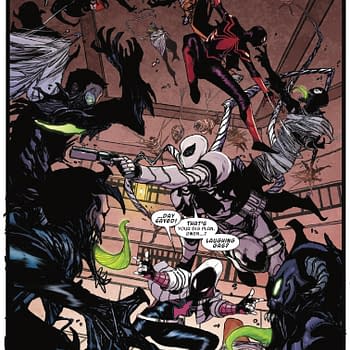Posted in: Comics | Tagged: avengers, Comics, entertainment, marvel, Marvel Comics, native american, red indian, red wolf, Secret Wars
So Where Is Red Wolf's Shirt Anyway?
Kenneth Kimbrough writes for Bleeding Cool:
Two weeks ago, Marvel announced that the Native American character, Red Wolf, would soon receive his own series. While I was excited to hear that a Cheyenne character would be headlining his own book, I became worried once I saw the corresponding publicity image. Where was Red Wolf's shirt? Comics' lack of Native Americans with shirts has become something of a joke between myself and one of my professors who works with Native American literature. I regularly share portrayals of Native Americans in comics, and we discuss how wrongheaded many of them are. And sadly, many mainstream publishers have had more harmful images than helpful. On the openly malicious side, both Batman (Batman #86) and Superman (Action Comics #148) have had stories that involved the heroes either stepping in as white saviors or fending off Native American land claims (land claims that are one hundred percent legitimate, by the way).

Their costumes generally include feathers, war paint, war bonnets, moccasins, bone breastplates and pseudo-Native American symbols employed not for historical accuracy but rather to drive home the point that the characters are indeed Native Americans. Their powers also tend to involve Indigenous religion or spirituality in some way (e.g., Red Wolf, Forge, Puma, Talisman, and of course, Shaman). Michael Sheyahshe, in Native Americans in Comic Books, compares these innate spiritual abilities to assuming that "within every Anglo…there is a latent priest/scientist/doctor." Not only is the assumption ridiculous, but it elides the fact that being a spiritual leader ("shaman" is a contentious term in recent Native scholarship) requires just as much expert training.
When Red Wolf (William Talltrees) was originally introduced by Roy Thomas and John Buscema in Avengers #80, he followed many of these design rules, and although well-intentioned, his introduction is laden with awkward, condescending dialogue and narration, often with reference to the color of his skin (I'll give you three guesses as to which color). John Ostrander did a better job cutting out the pidgin English, but the character's look was still problematic. Most recently, Red Wolf appeared as part of the Rangers in Scarlet Spider. In this version, he sported a breastplate in lieu of a shirt.
However, it hasn't escaped my attention that Red Wolf's series takes place in the world of Secret Wars: 1872. And if Hollywood is to be believed, 1872 is long before The Cheyenne had developed the technology known as the shirt. But here in the real world, any glance at Cheyenne portraits from 1872 reveals that the myth of the shirtless Native American is patently false. Below are some Southern Cheyenne men in 1879, and as you can see, everyone is fully clothed. This particular picture is from the forums on www.American-Tribes.com. But more pictures are available at www.firstpeople.us.

Often, the images reported to the mother country were exaggerated (if not wholly manufactured) to contrive a rationale for expeditions and missions of "civilization." A similar case is the Twilight films and novels with their depictions of Native Americans as "savage" werewolves in contrast to the "civilized" and literally white vampires. The image of the shirtless Indigenous person is a very old one that persisted into the twentieth century and was eventually adapted to other ends. While many Native American tribes fought—and still fight—for legal recognition from the U.S. government, popular media has continued to depict American Indians as shirtless, uncivilized people who (ironically) don't fit into U.S. culture. This outsider status has usually been depicted by placing Native Americans as cannon fodder for cowboys in Westerns and as narrative obstacles rather than actual people. Nonetheless, the shirtless Native American is an old image that has persisted through centuries, and its use is almost never benign.


Red Wolf's solo series may still be at a stage where some care with visual design could preempt an offensive misfire. Marvel even has other Native American heroes with great costumes that aren't stereotypical. Wyatt Wingfoot, Forge, Dani Moonstar and American Eagle (the leather jacket version) are all great Native American heroes who stand on their own and (usually) don't play into cultural stereotypes. Special care should be given to trying to understand the implications of Red Wolf's visual design and how that fits into larger discussions of Native Americans in popular media and cultural misappropriation. In an ideal world, Red Wolf would be written and illustrated by people intimately familiar with Cheyenne imagery and worldviews. There are plenty of Southern Cheyenne and Cheyenne Arapaho writers and artists who would probably love to reinvent the character. At the very least, just give Red Wolf a shirt (not just a breastplate). 45 years is long enough.
Kenneth D. Kimbrough studies comics and film at the University of Oklahoma. All heckling should be directed at his poorly-maintained twitter, @KennethCSquared.












